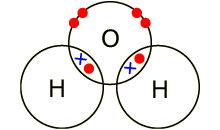Question #f4a58
1 Answer
A covalent bond is formed by the sharing of a pair of electrons between 2 atoms. In forming covalent bonds, each atom acquires the same electronic structure as a noble gas which is an octet structure for most elements but a duplet structure for Hydrogen, Lithium, Beryllium, Boron and sometimes Carbon. A covalent bond is formed between atoms of non-metals.
An example of a covalent compound is Water,
Hydrogen having 1 valence electron needs another valence electron to achieve a duplet structure or a stable electron configuration.
Oxygen has 6 valence electrons and needs 2 valence electrons to achieve an octect structure which is a stable electron configuration.
Since both Hydrogen and Oxygen are non-metals, they will have a covalent bond between them.
As Hydrogen and Oxygen both require more electrons to achieve a stable electron configuration, there is no transfer of electrons between the 2 atoms.
Below shows a dot and cross diagram of a water molecule
Red dots represents valence electrons of Oxygen.
The Blue crosses represent valence electrons of Hydrogen.
An oxygen atom needs two more electrons to fill its outer shell, hydrogen atoms need only one more electron to fill its outer shell.
As each hydrogen atom needs 1 more electron while one oxygen atom needs 2 more electrons, 1 electron from each of the 2 Hydrogen atoms is shared with 1 oxygen atom, hence the oxygen atom has 2 electrons from each of the 2 hydrogen atoms being shared with it, thus the oxygen atom has now a stable electron configuration.
Each of the 2 hydrogen atoms has to have 1 more electron to fill its outer shell. Hence, 1 electron from oxygen is shared with each of the 2 hydrogen atoms. Therefore, allowing the hydrogen atoms to fill its outer shell to become stable.

Hence, the stable balance of attractive and repulsive forces between atoms when they share electrons is known as covalent bonding.

